Report: Business Communication Challenges and Personal Reflection
VerifiedAdded on 2020/05/16
|9
|1871
|252
Report
AI Summary
This report delves into the intricacies of business communication and organizational culture, exploring their definitions and interconnectedness. It identifies significant challenges such as language barriers, technical errors, and irresponsible work habits in organizational communication, alongside issues like hampered innovation, cultural conflicts, and decreased motivation within organizational culture. The report offers a critical analysis of these challenges, providing insights into their impact on business operations. Furthermore, it includes a personal reflection, where the student, drawing upon experiences as a software developer, utilizes Gibb's Reflective Cycle to analyze personal encounters with communication and cultural barriers in a global setting. The reflection highlights the importance of adapting to diverse communication styles and cultural norms for professional success, outlining specific actions taken to overcome these challenges, such as learning British accents and studying British communication styles. The conclusion emphasizes the necessity of fostering healthy organizational communication through measures like employee involvement, training, and perks to create a positive and productive work environment.
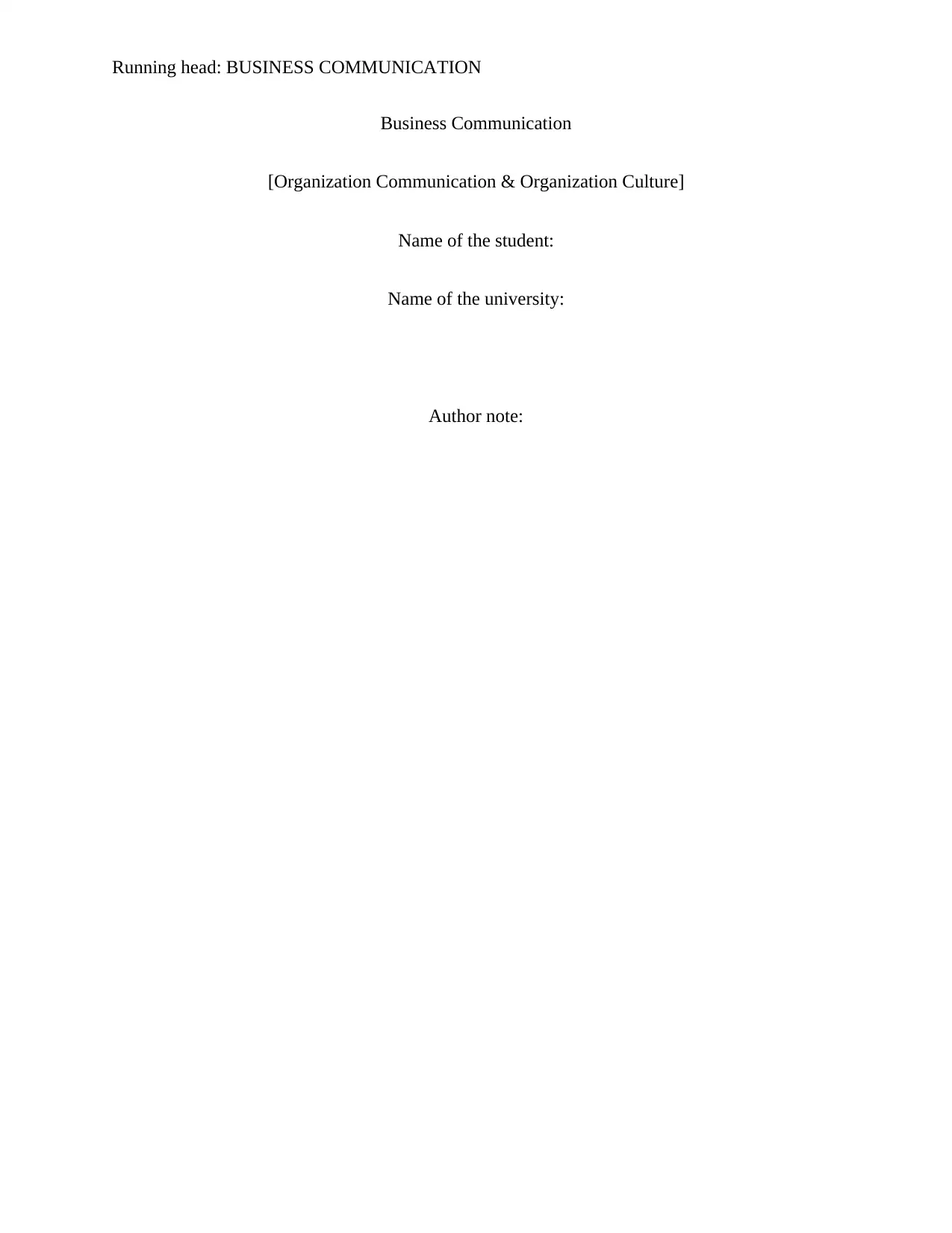
Running head: BUSINESS COMMUNICATION
Business Communication
[Organization Communication & Organization Culture]
Name of the student:
Name of the university:
Author note:
Business Communication
[Organization Communication & Organization Culture]
Name of the student:
Name of the university:
Author note:
Paraphrase This Document
Need a fresh take? Get an instant paraphrase of this document with our AI Paraphraser
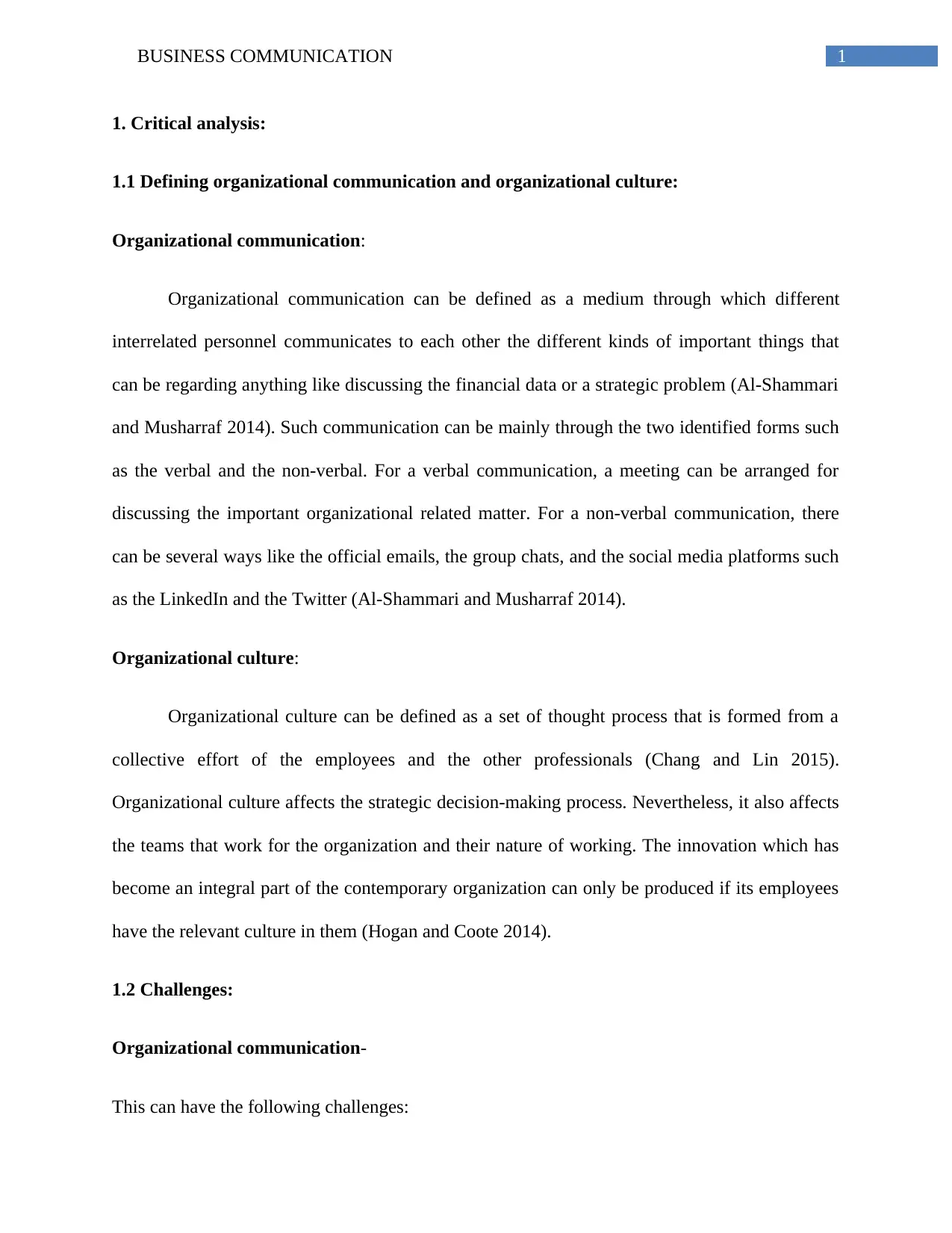
1BUSINESS COMMUNICATION
1. Critical analysis:
1.1 Defining organizational communication and organizational culture:
Organizational communication:
Organizational communication can be defined as a medium through which different
interrelated personnel communicates to each other the different kinds of important things that
can be regarding anything like discussing the financial data or a strategic problem (Al-Shammari
and Musharraf 2014). Such communication can be mainly through the two identified forms such
as the verbal and the non-verbal. For a verbal communication, a meeting can be arranged for
discussing the important organizational related matter. For a non-verbal communication, there
can be several ways like the official emails, the group chats, and the social media platforms such
as the LinkedIn and the Twitter (Al-Shammari and Musharraf 2014).
Organizational culture:
Organizational culture can be defined as a set of thought process that is formed from a
collective effort of the employees and the other professionals (Chang and Lin 2015).
Organizational culture affects the strategic decision-making process. Nevertheless, it also affects
the teams that work for the organization and their nature of working. The innovation which has
become an integral part of the contemporary organization can only be produced if its employees
have the relevant culture in them (Hogan and Coote 2014).
1.2 Challenges:
Organizational communication-
This can have the following challenges:
1. Critical analysis:
1.1 Defining organizational communication and organizational culture:
Organizational communication:
Organizational communication can be defined as a medium through which different
interrelated personnel communicates to each other the different kinds of important things that
can be regarding anything like discussing the financial data or a strategic problem (Al-Shammari
and Musharraf 2014). Such communication can be mainly through the two identified forms such
as the verbal and the non-verbal. For a verbal communication, a meeting can be arranged for
discussing the important organizational related matter. For a non-verbal communication, there
can be several ways like the official emails, the group chats, and the social media platforms such
as the LinkedIn and the Twitter (Al-Shammari and Musharraf 2014).
Organizational culture:
Organizational culture can be defined as a set of thought process that is formed from a
collective effort of the employees and the other professionals (Chang and Lin 2015).
Organizational culture affects the strategic decision-making process. Nevertheless, it also affects
the teams that work for the organization and their nature of working. The innovation which has
become an integral part of the contemporary organization can only be produced if its employees
have the relevant culture in them (Hogan and Coote 2014).
1.2 Challenges:
Organizational communication-
This can have the following challenges:
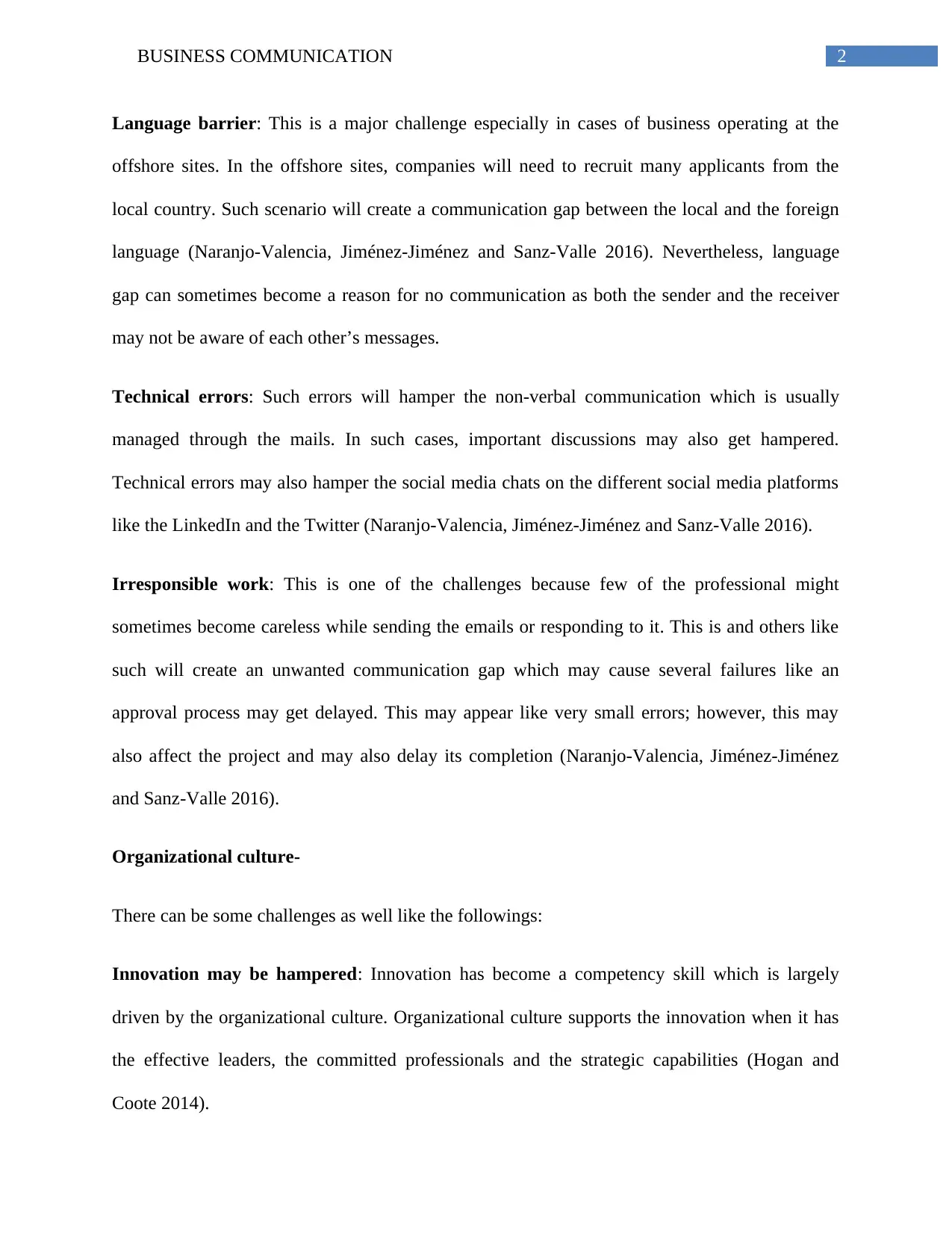
2BUSINESS COMMUNICATION
Language barrier: This is a major challenge especially in cases of business operating at the
offshore sites. In the offshore sites, companies will need to recruit many applicants from the
local country. Such scenario will create a communication gap between the local and the foreign
language (Naranjo-Valencia, Jiménez-Jiménez and Sanz-Valle 2016). Nevertheless, language
gap can sometimes become a reason for no communication as both the sender and the receiver
may not be aware of each other’s messages.
Technical errors: Such errors will hamper the non-verbal communication which is usually
managed through the mails. In such cases, important discussions may also get hampered.
Technical errors may also hamper the social media chats on the different social media platforms
like the LinkedIn and the Twitter (Naranjo-Valencia, Jiménez-Jiménez and Sanz-Valle 2016).
Irresponsible work: This is one of the challenges because few of the professional might
sometimes become careless while sending the emails or responding to it. This is and others like
such will create an unwanted communication gap which may cause several failures like an
approval process may get delayed. This may appear like very small errors; however, this may
also affect the project and may also delay its completion (Naranjo-Valencia, Jiménez-Jiménez
and Sanz-Valle 2016).
Organizational culture-
There can be some challenges as well like the followings:
Innovation may be hampered: Innovation has become a competency skill which is largely
driven by the organizational culture. Organizational culture supports the innovation when it has
the effective leaders, the committed professionals and the strategic capabilities (Hogan and
Coote 2014).
Language barrier: This is a major challenge especially in cases of business operating at the
offshore sites. In the offshore sites, companies will need to recruit many applicants from the
local country. Such scenario will create a communication gap between the local and the foreign
language (Naranjo-Valencia, Jiménez-Jiménez and Sanz-Valle 2016). Nevertheless, language
gap can sometimes become a reason for no communication as both the sender and the receiver
may not be aware of each other’s messages.
Technical errors: Such errors will hamper the non-verbal communication which is usually
managed through the mails. In such cases, important discussions may also get hampered.
Technical errors may also hamper the social media chats on the different social media platforms
like the LinkedIn and the Twitter (Naranjo-Valencia, Jiménez-Jiménez and Sanz-Valle 2016).
Irresponsible work: This is one of the challenges because few of the professional might
sometimes become careless while sending the emails or responding to it. This is and others like
such will create an unwanted communication gap which may cause several failures like an
approval process may get delayed. This may appear like very small errors; however, this may
also affect the project and may also delay its completion (Naranjo-Valencia, Jiménez-Jiménez
and Sanz-Valle 2016).
Organizational culture-
There can be some challenges as well like the followings:
Innovation may be hampered: Innovation has become a competency skill which is largely
driven by the organizational culture. Organizational culture supports the innovation when it has
the effective leaders, the committed professionals and the strategic capabilities (Hogan and
Coote 2014).
⊘ This is a preview!⊘
Do you want full access?
Subscribe today to unlock all pages.

Trusted by 1+ million students worldwide
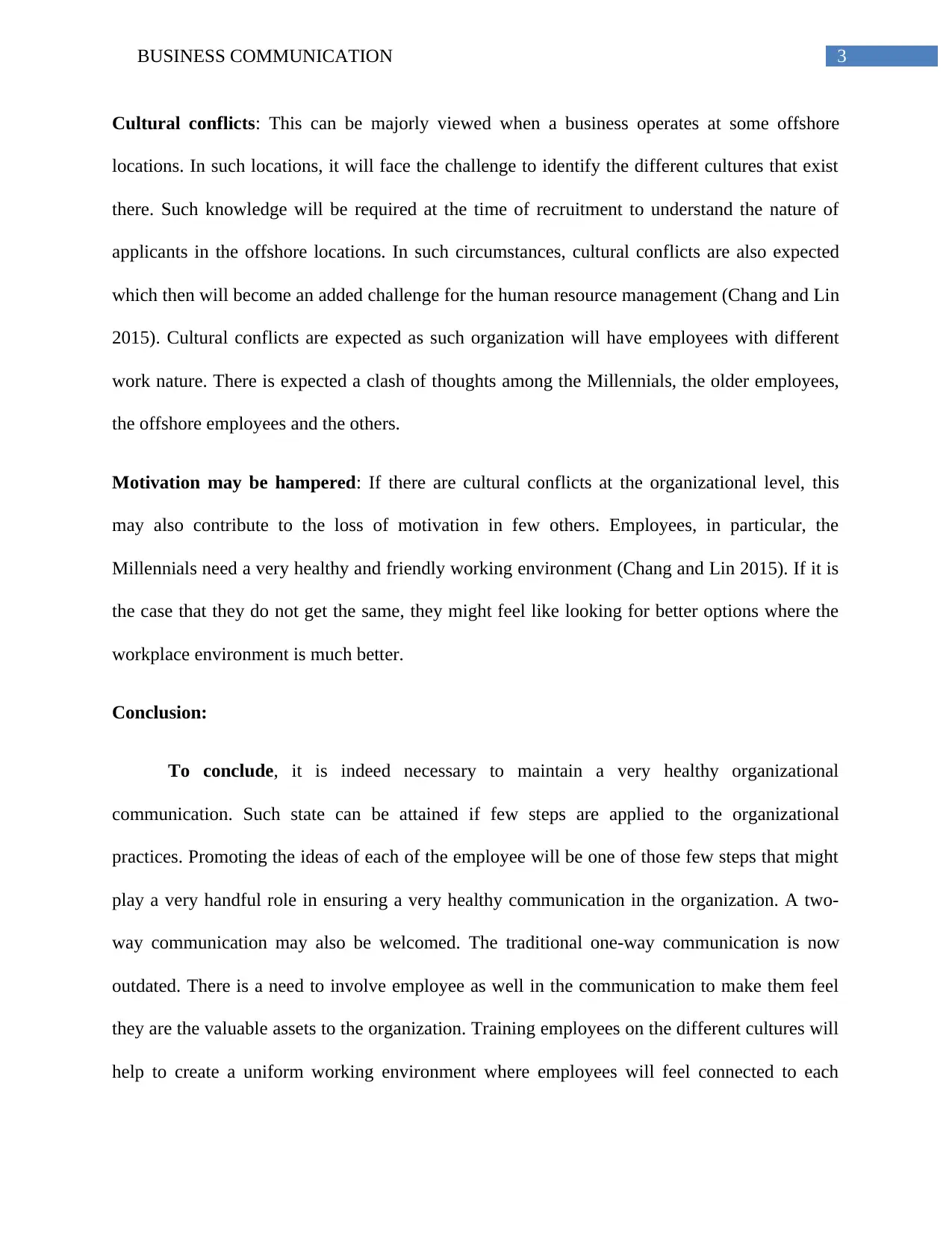
3BUSINESS COMMUNICATION
Cultural conflicts: This can be majorly viewed when a business operates at some offshore
locations. In such locations, it will face the challenge to identify the different cultures that exist
there. Such knowledge will be required at the time of recruitment to understand the nature of
applicants in the offshore locations. In such circumstances, cultural conflicts are also expected
which then will become an added challenge for the human resource management (Chang and Lin
2015). Cultural conflicts are expected as such organization will have employees with different
work nature. There is expected a clash of thoughts among the Millennials, the older employees,
the offshore employees and the others.
Motivation may be hampered: If there are cultural conflicts at the organizational level, this
may also contribute to the loss of motivation in few others. Employees, in particular, the
Millennials need a very healthy and friendly working environment (Chang and Lin 2015). If it is
the case that they do not get the same, they might feel like looking for better options where the
workplace environment is much better.
Conclusion:
To conclude, it is indeed necessary to maintain a very healthy organizational
communication. Such state can be attained if few steps are applied to the organizational
practices. Promoting the ideas of each of the employee will be one of those few steps that might
play a very handful role in ensuring a very healthy communication in the organization. A two-
way communication may also be welcomed. The traditional one-way communication is now
outdated. There is a need to involve employee as well in the communication to make them feel
they are the valuable assets to the organization. Training employees on the different cultures will
help to create a uniform working environment where employees will feel connected to each
Cultural conflicts: This can be majorly viewed when a business operates at some offshore
locations. In such locations, it will face the challenge to identify the different cultures that exist
there. Such knowledge will be required at the time of recruitment to understand the nature of
applicants in the offshore locations. In such circumstances, cultural conflicts are also expected
which then will become an added challenge for the human resource management (Chang and Lin
2015). Cultural conflicts are expected as such organization will have employees with different
work nature. There is expected a clash of thoughts among the Millennials, the older employees,
the offshore employees and the others.
Motivation may be hampered: If there are cultural conflicts at the organizational level, this
may also contribute to the loss of motivation in few others. Employees, in particular, the
Millennials need a very healthy and friendly working environment (Chang and Lin 2015). If it is
the case that they do not get the same, they might feel like looking for better options where the
workplace environment is much better.
Conclusion:
To conclude, it is indeed necessary to maintain a very healthy organizational
communication. Such state can be attained if few steps are applied to the organizational
practices. Promoting the ideas of each of the employee will be one of those few steps that might
play a very handful role in ensuring a very healthy communication in the organization. A two-
way communication may also be welcomed. The traditional one-way communication is now
outdated. There is a need to involve employee as well in the communication to make them feel
they are the valuable assets to the organization. Training employees on the different cultures will
help to create a uniform working environment where employees will feel connected to each
Paraphrase This Document
Need a fresh take? Get an instant paraphrase of this document with our AI Paraphraser
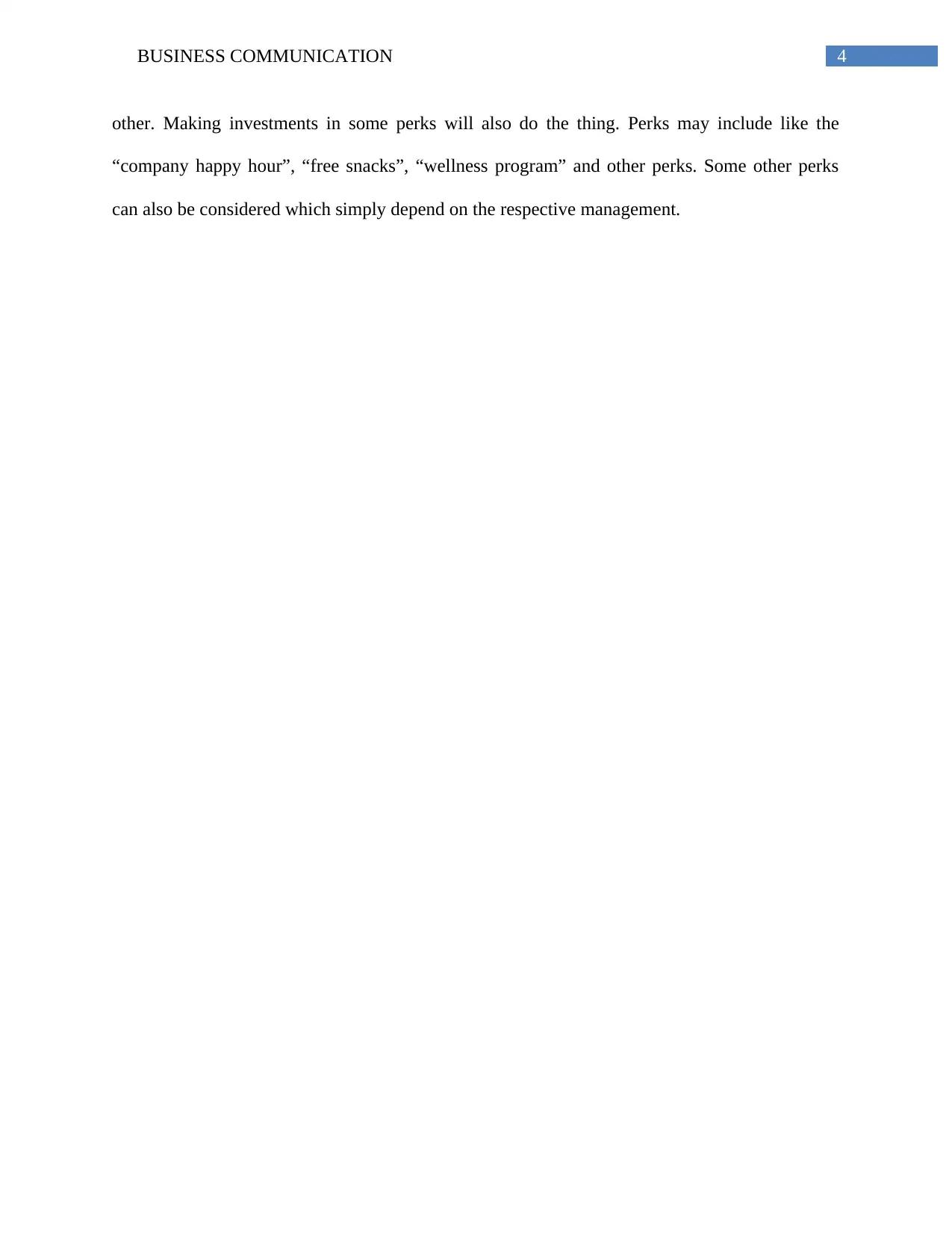
4BUSINESS COMMUNICATION
other. Making investments in some perks will also do the thing. Perks may include like the
“company happy hour”, “free snacks”, “wellness program” and other perks. Some other perks
can also be considered which simply depend on the respective management.
other. Making investments in some perks will also do the thing. Perks may include like the
“company happy hour”, “free snacks”, “wellness program” and other perks. Some other perks
can also be considered which simply depend on the respective management.
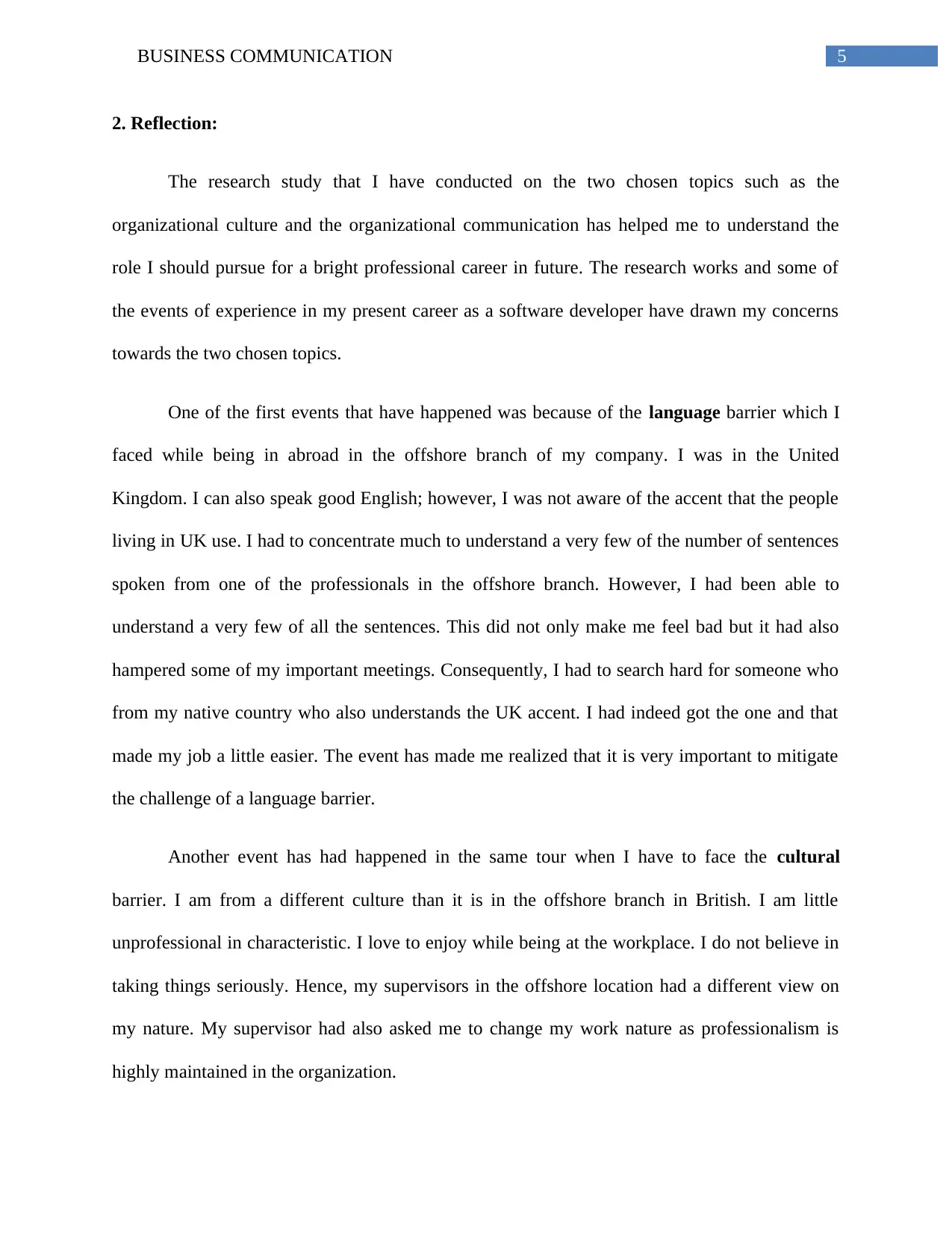
5BUSINESS COMMUNICATION
2. Reflection:
The research study that I have conducted on the two chosen topics such as the
organizational culture and the organizational communication has helped me to understand the
role I should pursue for a bright professional career in future. The research works and some of
the events of experience in my present career as a software developer have drawn my concerns
towards the two chosen topics.
One of the first events that have happened was because of the language barrier which I
faced while being in abroad in the offshore branch of my company. I was in the United
Kingdom. I can also speak good English; however, I was not aware of the accent that the people
living in UK use. I had to concentrate much to understand a very few of the number of sentences
spoken from one of the professionals in the offshore branch. However, I had been able to
understand a very few of all the sentences. This did not only make me feel bad but it had also
hampered some of my important meetings. Consequently, I had to search hard for someone who
from my native country who also understands the UK accent. I had indeed got the one and that
made my job a little easier. The event has made me realized that it is very important to mitigate
the challenge of a language barrier.
Another event has had happened in the same tour when I have to face the cultural
barrier. I am from a different culture than it is in the offshore branch in British. I am little
unprofessional in characteristic. I love to enjoy while being at the workplace. I do not believe in
taking things seriously. Hence, my supervisors in the offshore location had a different view on
my nature. My supervisor had also asked me to change my work nature as professionalism is
highly maintained in the organization.
2. Reflection:
The research study that I have conducted on the two chosen topics such as the
organizational culture and the organizational communication has helped me to understand the
role I should pursue for a bright professional career in future. The research works and some of
the events of experience in my present career as a software developer have drawn my concerns
towards the two chosen topics.
One of the first events that have happened was because of the language barrier which I
faced while being in abroad in the offshore branch of my company. I was in the United
Kingdom. I can also speak good English; however, I was not aware of the accent that the people
living in UK use. I had to concentrate much to understand a very few of the number of sentences
spoken from one of the professionals in the offshore branch. However, I had been able to
understand a very few of all the sentences. This did not only make me feel bad but it had also
hampered some of my important meetings. Consequently, I had to search hard for someone who
from my native country who also understands the UK accent. I had indeed got the one and that
made my job a little easier. The event has made me realized that it is very important to mitigate
the challenge of a language barrier.
Another event has had happened in the same tour when I have to face the cultural
barrier. I am from a different culture than it is in the offshore branch in British. I am little
unprofessional in characteristic. I love to enjoy while being at the workplace. I do not believe in
taking things seriously. Hence, my supervisors in the offshore location had a different view on
my nature. My supervisor had also asked me to change my work nature as professionalism is
highly maintained in the organization.
⊘ This is a preview!⊘
Do you want full access?
Subscribe today to unlock all pages.

Trusted by 1+ million students worldwide
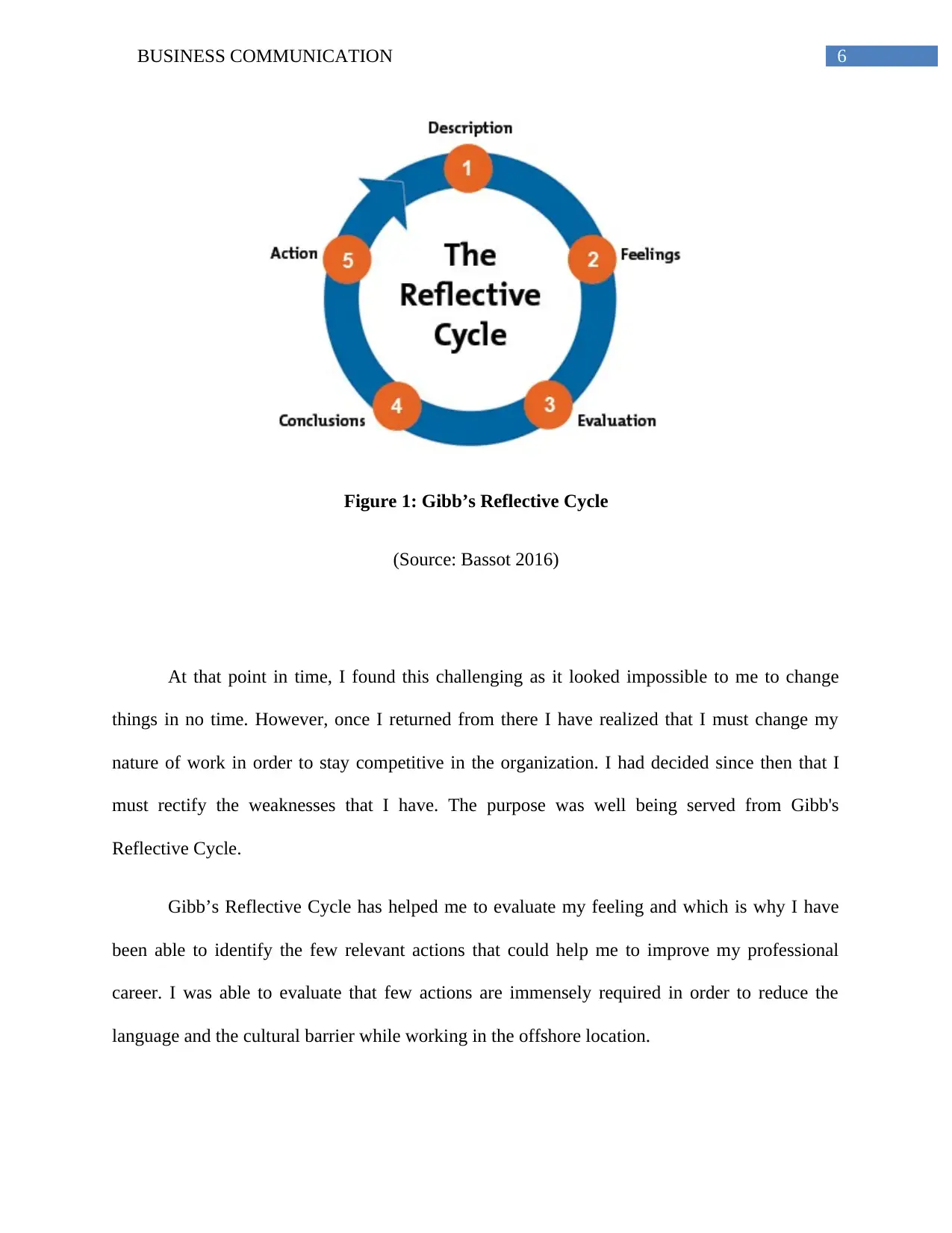
6BUSINESS COMMUNICATION
Figure 1: Gibb’s Reflective Cycle
(Source: Bassot 2016)
At that point in time, I found this challenging as it looked impossible to me to change
things in no time. However, once I returned from there I have realized that I must change my
nature of work in order to stay competitive in the organization. I had decided since then that I
must rectify the weaknesses that I have. The purpose was well being served from Gibb's
Reflective Cycle.
Gibb’s Reflective Cycle has helped me to evaluate my feeling and which is why I have
been able to identify the few relevant actions that could help me to improve my professional
career. I was able to evaluate that few actions are immensely required in order to reduce the
language and the cultural barrier while working in the offshore location.
Figure 1: Gibb’s Reflective Cycle
(Source: Bassot 2016)
At that point in time, I found this challenging as it looked impossible to me to change
things in no time. However, once I returned from there I have realized that I must change my
nature of work in order to stay competitive in the organization. I had decided since then that I
must rectify the weaknesses that I have. The purpose was well being served from Gibb's
Reflective Cycle.
Gibb’s Reflective Cycle has helped me to evaluate my feeling and which is why I have
been able to identify the few relevant actions that could help me to improve my professional
career. I was able to evaluate that few actions are immensely required in order to reduce the
language and the cultural barrier while working in the offshore location.
Paraphrase This Document
Need a fresh take? Get an instant paraphrase of this document with our AI Paraphraser
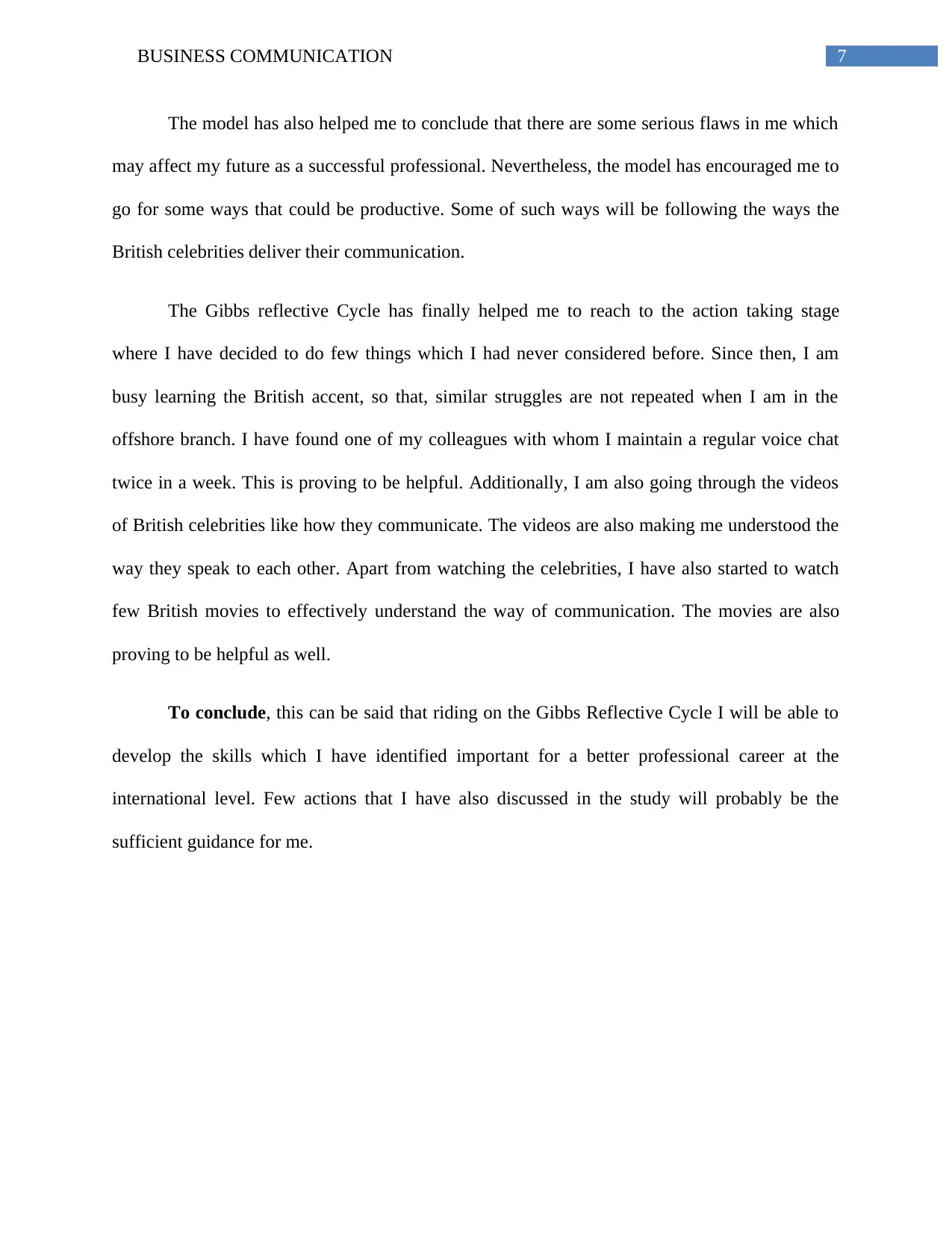
7BUSINESS COMMUNICATION
The model has also helped me to conclude that there are some serious flaws in me which
may affect my future as a successful professional. Nevertheless, the model has encouraged me to
go for some ways that could be productive. Some of such ways will be following the ways the
British celebrities deliver their communication.
The Gibbs reflective Cycle has finally helped me to reach to the action taking stage
where I have decided to do few things which I had never considered before. Since then, I am
busy learning the British accent, so that, similar struggles are not repeated when I am in the
offshore branch. I have found one of my colleagues with whom I maintain a regular voice chat
twice in a week. This is proving to be helpful. Additionally, I am also going through the videos
of British celebrities like how they communicate. The videos are also making me understood the
way they speak to each other. Apart from watching the celebrities, I have also started to watch
few British movies to effectively understand the way of communication. The movies are also
proving to be helpful as well.
To conclude, this can be said that riding on the Gibbs Reflective Cycle I will be able to
develop the skills which I have identified important for a better professional career at the
international level. Few actions that I have also discussed in the study will probably be the
sufficient guidance for me.
The model has also helped me to conclude that there are some serious flaws in me which
may affect my future as a successful professional. Nevertheless, the model has encouraged me to
go for some ways that could be productive. Some of such ways will be following the ways the
British celebrities deliver their communication.
The Gibbs reflective Cycle has finally helped me to reach to the action taking stage
where I have decided to do few things which I had never considered before. Since then, I am
busy learning the British accent, so that, similar struggles are not repeated when I am in the
offshore branch. I have found one of my colleagues with whom I maintain a regular voice chat
twice in a week. This is proving to be helpful. Additionally, I am also going through the videos
of British celebrities like how they communicate. The videos are also making me understood the
way they speak to each other. Apart from watching the celebrities, I have also started to watch
few British movies to effectively understand the way of communication. The movies are also
proving to be helpful as well.
To conclude, this can be said that riding on the Gibbs Reflective Cycle I will be able to
develop the skills which I have identified important for a better professional career at the
international level. Few actions that I have also discussed in the study will probably be the
sufficient guidance for me.
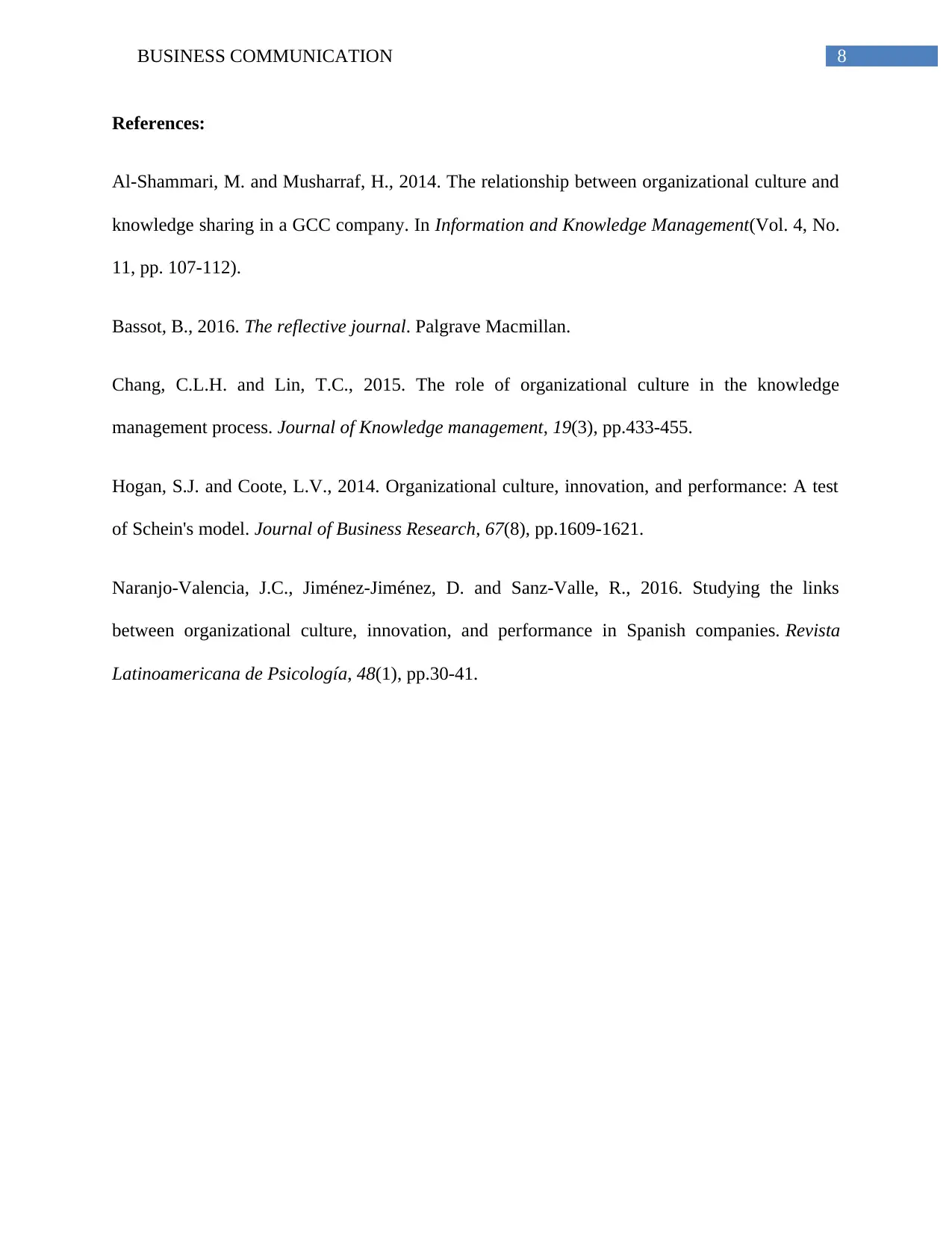
8BUSINESS COMMUNICATION
References:
Al-Shammari, M. and Musharraf, H., 2014. The relationship between organizational culture and
knowledge sharing in a GCC company. In Information and Knowledge Management(Vol. 4, No.
11, pp. 107-112).
Bassot, B., 2016. The reflective journal. Palgrave Macmillan.
Chang, C.L.H. and Lin, T.C., 2015. The role of organizational culture in the knowledge
management process. Journal of Knowledge management, 19(3), pp.433-455.
Hogan, S.J. and Coote, L.V., 2014. Organizational culture, innovation, and performance: A test
of Schein's model. Journal of Business Research, 67(8), pp.1609-1621.
Naranjo-Valencia, J.C., Jiménez-Jiménez, D. and Sanz-Valle, R., 2016. Studying the links
between organizational culture, innovation, and performance in Spanish companies. Revista
Latinoamericana de Psicología, 48(1), pp.30-41.
References:
Al-Shammari, M. and Musharraf, H., 2014. The relationship between organizational culture and
knowledge sharing in a GCC company. In Information and Knowledge Management(Vol. 4, No.
11, pp. 107-112).
Bassot, B., 2016. The reflective journal. Palgrave Macmillan.
Chang, C.L.H. and Lin, T.C., 2015. The role of organizational culture in the knowledge
management process. Journal of Knowledge management, 19(3), pp.433-455.
Hogan, S.J. and Coote, L.V., 2014. Organizational culture, innovation, and performance: A test
of Schein's model. Journal of Business Research, 67(8), pp.1609-1621.
Naranjo-Valencia, J.C., Jiménez-Jiménez, D. and Sanz-Valle, R., 2016. Studying the links
between organizational culture, innovation, and performance in Spanish companies. Revista
Latinoamericana de Psicología, 48(1), pp.30-41.
⊘ This is a preview!⊘
Do you want full access?
Subscribe today to unlock all pages.

Trusted by 1+ million students worldwide
1 out of 9
Your All-in-One AI-Powered Toolkit for Academic Success.
+13062052269
info@desklib.com
Available 24*7 on WhatsApp / Email
![[object Object]](/_next/static/media/star-bottom.7253800d.svg)
Unlock your academic potential
Copyright © 2020–2025 A2Z Services. All Rights Reserved. Developed and managed by ZUCOL.